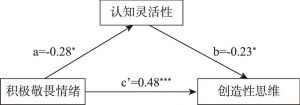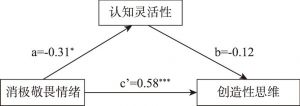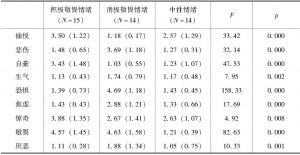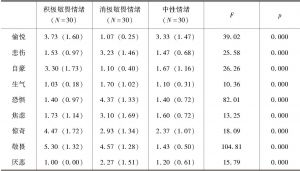论文
敬畏情绪对创造力的影响:认知灵活性的中介作用
摘要
本研究分别采用视频与VR的方式诱发被试的敬畏情绪,从创造力的测量指标——创造性思维的两个方面(发散性思维与聚合性思维)来探究敬畏情绪对创造力的影响,在引入敬畏情绪消极效价的同时,加入认知灵活性变量,进一步探讨其内部机制。结果发现:(1)不同效价的敬畏情绪都可以增强个体的创造力,具体表现为积极敬畏情绪增强发散思维的灵活性与独创性,消极敬畏情绪增强发散思维的流畅性与聚合思维;(2)敬畏情绪通过认知灵活性影响创造力的表现,认知灵活性在其中起中介作用。
作者
张潮 ,山西师范大学教育科学学院教授、硕士生导师。
安彦名 ,山西师范大学教育科学学院研究生。
刘金蕙 ,山西师范大学教育科学学院在读研究生。
吕一超 ,山西师范大学教育科学学院研究生。
喻丰 ,西安交通大学社会心理学研究所教授、博士生导师。
Zhang Chao
An Yan-ming
Liu Jin-hui
Lv Yi-chao
Yu Feng
检索正文关键字
论文目录
-
一 文献综述
- (一)创造力
- (二)敬畏情绪及其与创造力的关系
- (三)认知灵活性
-
二 研究1:不同效价的敬畏情绪对创造力的影响
- (一)研究方法
- 1.被试
- 2.研究设计
- 3.研究材料
- 4.研究过程
- (二)结果
- 1.情绪诱发效果的有效性检验
- 2.不同情绪状态下的发散性思维得分
- 3.不同情绪状态下的聚合性思维得分
- (三)讨论
- (一)研究方法
-
三 研究2:认知灵活性在不同效价的敬畏情绪和创造力之间的中介作用
- (一)研究方法
- 1.被试
- 2.研究设计
- 3.研究材料
- 4.研究过程
- (二)结果
- 1.情绪诱发效果的有效性检验
- 2.不同情绪状态下的发散性思维得分
- 3.不同情绪状态下的聚合性思维得分
- 4.认知灵活性的中介作用分析
- (三)讨论
- (一)研究方法
- 四 讨论与结论
查看更多>>>













